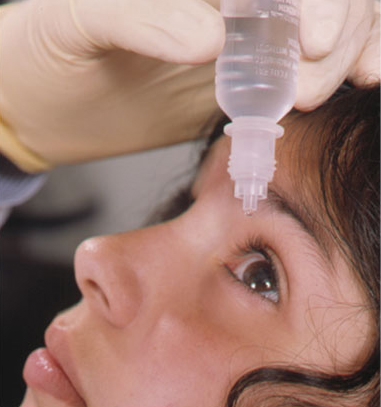 |
| The time to effective cycloplegia for cyclopentolate is often considered to be between 30 to 60 minutes, and even shorter for light-colored irises. Photo: Joseph Sowka, OD. Click image to enlarge. |
Effective cycloplegia can be one of the most challenging aspects of a pediatric eye examination. Active accommodation in children is the primary source of error in measurements, and many studies on the pediatric population have shown that a lack of cycloplegia may result in an overestimation of myopia and an underestimation of hyperopia. The cycloplegic effect of the standard drug used, cyclopentolate, can continue for 24 hours—or even longer. Many propose that tropicamide would be an excellent alternative to cyclopentolate, given its favorable pharmacokinetics, but it has always been considered an ineffective cycloplegic despite its wide use as a mydriatic.
Researchers in Jordan recently compared the final cycloplegic refraction for the same patients using both cyclopentolate 1% and tropicamide 1% on two separate visits. Their study, published in American Journal of Ophthalmology, demonstrated that cyclopentolate gives final cycloplegic refraction that is more plus or less minus than tropicamide, which is concordant with the current belief and the few studies that compared the two agents.
A total of 185 eyes from 94 patients between the ages of three and 16 (average= 8.8; 54.3% female) were included. Out of the total sample, 44.9% eyes were obtained from young children (three to seven years old), 32.4% were older children (eight to 11) and 22.7% were teenagers (12 to 16). The study assessed the spherical equivalent (SE) change at the time of effective cycloplegia. All children had brown irises, as the researchers noted that eyes of this color were not as efficiently responding to cycloplegic agents as lighter-colored ones. All children were allocated to one of five subgroups according to the SE obtained after full cycloplegia. These subgroups were:
Subgroup | Spherical Equivalent |
high myopia | above -5.0 |
myopia | between -0.5 and -5.0 |
emmetropia | between -0.5 and +0.5 |
hyperopia | between +0.5 and +5.0 |
high hyperopia | above +5.0 |
The average SE of both eyes before cycloplegia was -0.082D. The SE after instillation of cyclopentolate and tropicamide drops in both eyes was 1.07D and 0.96D respectively. The average change in SE after cycloplegia was 1.15D for cyclopentolate and 1.04D for tropicamide. The difference between change in SE of cyclopentolate and tropicamide was found statistically significant at 0.11D, however clinically insignificant. The change in SE between the two drops before and after cycloplegia in both eyes for all refractive error groups was clinically insignificant. The greatest effect of cyclopentolate and tropicamide was in hyperopic eyes with a change of SE of 1.54D and 1.39D respectively.
“Our study included the whole spectrum of refractive errors with age subgroup analysis,” the researchers wrote in their paper. They also highlighted the reproducibility of their results within the different refractive and age subgroups made it even more valid.
“Tropicamide can be considered a reliable and effective substitute to cyclopentolate for cycloplegic refraction in non-strabismic children,” the authors concluded. “We believe it can make a great relief for busy clinical practices, increase patient and parent satisfaction and have less effects on school attendance and performance.”
Al-Thawabieh W, Al-Omari R, Abu-Hassan DW, et al. Tropicamide vs. cyclopentolate for cycloplegic refraction in pediatric patients with brown irises: a randomized clinical trial. Am J Ophthalmol. October 3, 2023. [Epub ahead of print]. |

